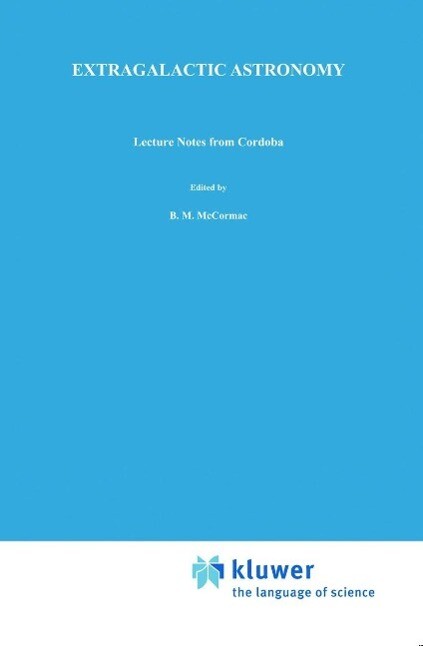Zur Zeit liegt uns keine Inhaltsangabe vor.
Inhaltsverzeichnis
I: Forms and Structures. - 1. 1. Normal and Peculiar Galaxies. - 1. 2. Classification of Normal Galaxies. - 1. 3. Apparent and True Flattening of Galaxies. - 1. 4. Other Classifications Systems. - 1. 5. Classification of Peculiar Galaxies. - II: Normal Galaxies. - II. 1. Contents. - II. 1. 1. Photometric Properties. - II. 1. 2. Stellar Content. - II. 1. 3. The Interstellar Medium in Galaxies. - II. 1. 4. Subsystems. - II. 2. Motions and Masses. - II. 2. 1. Kinematics. - II. 2. 2. Masses of Galaxies. - II. 2. 3. Mass-Luminosity Ratios. - II. 3. 2. Evolution of Galactic Content. - III: Active Galaxies. - III. 1. Classification. - III. 2. Intergalactic H II Regions (IG H II). - III. 3. Galaxies with Nuclear Emission (neG). - III. 4. Irr II Galaxies. - III. 5. Seyfert Galaxies (SyG). - III. 5. 1. Spectrum of Emission. - III. 5. 2. Continuum Spectrum. - III. 5. 3. Variability. - III. 5. 4. Radioemission. - III. 5. 5. Correlations. - III. 6. Strong Radio Galaxies (SRG). - III. 6. 1. Radio Structures. - III. 6. 2. Spectrum of Radio Frequencies. - III. 6. 3. Time Scale. - III. 6. 4. Compact Sources. - III. 6. 5. Optical Forms Associated with SRG s. - III. 6. 6. Optical Spectra. - III. 6. 7. Energetics of SRG s. - III. 7. N Galaxies. - III. 8. Quasi Stellar Objects (QSO). - III. 8. 1. Continuum Spectrum. - III. 8. 2. Line Spectrum. - III. 8. 3. BL Lacertae Objects. - III. 8. 4. Redshifts and Nature of the QSO s. - III. 9. Activity in Compact Objects. - III. 9. 1. Excitation Mechanism. - III. 9. 2. The Source of Energy. - IV: Galaxies and their Environment. - IV. 1. Tidal Interactions. - IV. 1. 2. Non-tidal Interactions. - IV. 2. Agregates of Galaxies. - IV. 2. 1. Pairs and Multiplets. - IV. 2. 2. Groups of Galaxies. - IV. 2. 3. Clusters. - IV. 2. 4. Second Order Clustering. - IV. 2. 5. Clustering. - IV. 3. Mean Mass Density of Matter in the Universe. - V: Measuring the Universe. - V. 1. Distance Indicators. -V. 1. 1. Primary Distance Indicators. - V. 1. 2. Other Photometric Indicators. - V. 1. 3. Geometric Indicators. - V. 1. 4. Other Indicators. - V. 2. The Scale of Distances. - V. 2. 1. The Hubble Flow. - V. 2. 2. The Quest for H0. - V. 3. Far Away and Long Ago. - V. 3. 1. TheRedshift. - V. 3. 2. The Hubble Law. - VI: Cosmology. - VI. 1. Basic Assumptions. - VI. 2. Explosive Cosmologies. - VI. 3. Thermal Evolution of the Universe. - VI. 4. Primaeval Nucleosynthesis. - VI. 5. The Background Radiation. - VI. 6. Observational Cosmology. - VI. 6. 1. Observable Parameters. - VI. 6. 2. Fitting the Model to the Universe. - VI. 6. 3. Lifting the Restriction ? = 0. - VII: Gravitational Instability and Galaxy Formation. - VII. 1. Theory of Jeans Wavelength and Mass. - VII. 1. 1. The Jeans Mass. - VII. 2. Gravitational Instability in an Expanding Universe. - VII. 2. 1. The Era of Gravitational Instability. - VII. 3. Protogalaxies. - VII. 3. 1. Non-linear Growth of a Density Perturbation. - VII. 4. Galaxy Formation Through Dissipative Collapse. - VII. 4. 1. Stationary State out of Equilibrium. - VII. 4. 2. Hierarchy of Fragmentations. - VII. 4. 3. The End of the Hierarchy. - VII. 4. 4. Global Dynamics. - VII. 4. 5. The Influence of Rotation. - VI. 5. Dissipationless Collapse. - VIII: Notes and Comments. - VII. 1. Catalogs and Atlas of Galaxies. - VIII. 2. Composite Spectra. - VIII. 3. The H I Spectrum. - VIII. 4. Determination of Rotation Curves. - VIII. 5. Rotation Period of Central Regions in Galaxies. - VIII. 6. Note for Section V. 1. 3.












